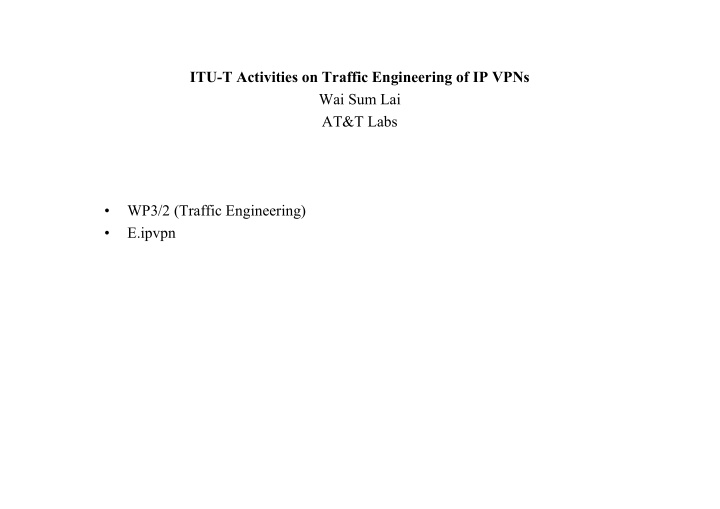



ITU-T Activities on Traffic Engineering of IP VPNs Wai Sum Lai AT&T Labs • WP3/2 (Traffic Engineering) • E.ipvpn
ITU-T Study Group 2, Working Party 3 (Traffic Engineering) http://www.itu.int/ITU-T/com2/index.html 3 Questions (in Working Party 3) • Q7/2 Traffic engineering for personal communications • Q8/2 Traffic engineering for SS No.7- and IP-based signaling networks • Q9/2 Traffic engineering for networks supporting IP services Related Question (in Working Party 1) • Q2/2 Routing and interworking plans for fixed and mobile networks
ITU-T WP 3/2 (Traffic Engineering) 5 major categories of Recommendations • General aspects and reference connections • Traffic modeling • Grade of Service • Control and dimensioning methods • Traffic measurements Recommendation series E.700-series ISDN, including ATM-based B-ISDN E.750-series Mobile networks E.650-series IP-based networks E.651 Reference Connections for Traffic Engineering of IP Access Networks E.671 Post Selection Delay in PSTN/ISDNs Using Internet Telephony for a Portion of the Connection E.hfc Traffic Engineering Methods for IP Access Networks based on Hybrid Fiber-Coax System E.ipvpn Traffic Engineering Methods for Network-Based IP Virtual Private Networks
E.ipvpn Traffic Engineering Methods for Network-Based IP Virtual Private Networks Objectives • describes generic methods for traffic control and dimensioning of a service provider’s network in supporting VPNs so that site-to-site performance may be assured • aims at achieving multivendor interoperability of traffic engineering implementations in provider networks Work has just started recently in WP 3/2. Further development requires inputs from IETF ppvpn and ITU-T Q11/13 (e.g., number and types of service classes to be offered, the use of backdoor link for traffic engineering)
Internet Draft Service requirements for Provider Provisioned Virtual Private Networks Numerical assumptions • support of a very large number, on the order of 1,000,000 , of VPNs per Service Provider network • support of a wide range of number of site interfaces per VPN (depending on size or structure of the customer organization): ranging from a few site interfaces to 50,000 site interfaces per VPN per customer • support of a wide range of number of routes per VPN : ranging from few to 200,000 routes per VPN These quantities are useful indications regarding how a provider network should scale. They also have a significant impact on the methods of traffic engineering to be used. It may be useful to specify also expected averages in the initial roll-out.
Recommend
More recommend